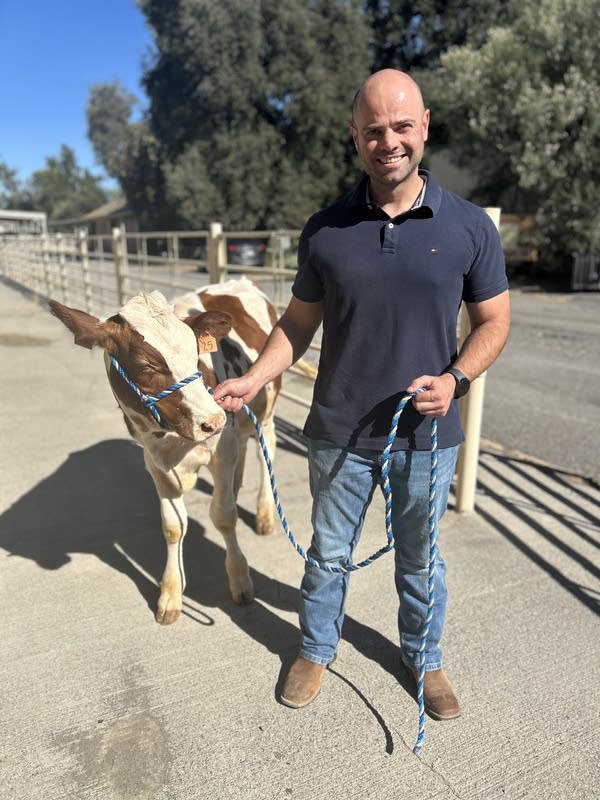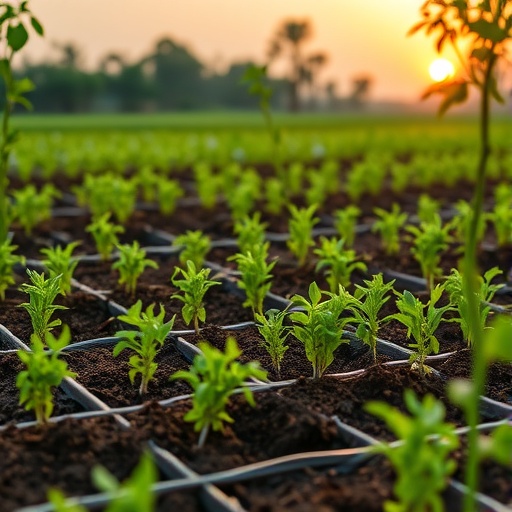Could an early diet of seaweed produce climate-friendlier beef? – marketplace.org

Report on Methane Reduction in Livestock and its Alignment with Sustainable Development Goals
1.0 Introduction: Addressing Climate Action (SDG 13) through Agricultural Innovation
A research initiative at the University of California, Davis is investigating the efficacy of a seaweed-based feed additive to reduce methane emissions from cattle. This study directly addresses the urgent need for climate action, as stipulated in Sustainable Development Goal 13, by targeting a significant source of greenhouse gases from the agricultural sector. The project aligns with global efforts to foster sustainable production patterns (SDG 12) and ensure long-term food security (SDG 2).
2.0 Research Methodology and Objectives
The study, managed by postdoctoral fellow Paulo de Meo Filho, employs a controlled trial to assess the impact of the seaweed additive. The primary objective is to determine if early-life intervention can produce lasting reductions in methane, a critical step for making the solution viable for grazing cattle and advancing sustainable agricultural practices.
2.1 Trial Groups
- Control Group: Receives a standard diet with no seaweed additive.
- Short-Term Treatment Group: Receives the additive from the second day of life until three months of age.
- Long-Term Treatment Group: Receives the additive from two months to approximately 18 months of age.
2.2 Mechanism and Measurement
- The active compound in the seaweed, bromoform, functions by inhibiting methane production in the cattle’s rumen.
- Emissions are measured using specialized sensors that analyze the animals’ exhalations and belching, which account for approximately 95% of their methane output.
3.0 Preliminary Findings and Implications for Sustainable Goals
The research, led by Professor Ermias Kebreab, has yielded promising initial results that could significantly contribute to achieving targets related to SDG 13 (Climate Action) and SDG 2 (Zero Hunger) by mitigating the environmental impact of livestock, which accounts for 12% to 20% of global greenhouse gas emissions.
3.1 Key Results
- Previous research has demonstrated that seaweed-based supplements can reduce methane emissions by as much as 90% in feedlot cattle.
- In the current UC Davis study, the short-term treatment group demonstrated a sustained 20% reduction in methane five months after the treatment was discontinued, suggesting a potential long-term solution.
3.2 Broader Impact on SDGs
- SDG 9 (Industry, Innovation, and Infrastructure): The study represents a significant scientific innovation with the potential to upgrade the livestock industry towards greater sustainability.
- SDG 12 (Responsible Consumption and Production): If successful and scalable, this intervention can create a more sustainable production model for beef and dairy, reducing the environmental footprint of consumption.
- SDG 14 (Life Below Water): The solution utilizes a marine resource, highlighting the potential for sustainable aquaculture to contribute to land-based climate solutions.
4.0 Future Directions and Considerations
While the reduction of enteric methane is a primary objective, the research acknowledges the broader environmental context of livestock production. Professor Kebreab’s team is also exploring gene-editing technologies as an alternative pathway to the same goal. It is noted that this research focuses on a critical component of livestock’s climate impact. Addressing other factors, such as deforestation and fertilizer use, remains essential for a holistic approach to achieving sustainable agricultural systems in line with the comprehensive vision of the Sustainable Development Goals.
Analysis of Sustainable Development Goals in the Article
1. Which SDGs are addressed or connected to the issues highlighted in the article?
- SDG 13: Climate Action – The article’s central theme is a research study aimed at reducing methane, a potent greenhouse gas, from livestock. This directly addresses the need to combat climate change and its impacts. The text states that “livestock production contributes between 12% and nearly 20% of global greenhouse gas emissions, mostly from methane.”
- SDG 2: Zero Hunger – The research focuses on making livestock farming, a critical component of global food systems, more sustainable. By reducing the environmental footprint of beef production, the study contributes to creating sustainable food production systems, which is a key aspect of achieving food security.
- SDG 9: Industry, Innovation and Infrastructure – The article highlights scientific research and technological innovation at the University of California, Davis. The development of a seaweed-based feed additive, the use of specialized sensors to measure emissions, and the exploration of gene editing are all examples of innovation aimed at making the agricultural industry more sustainable.
- SDG 12: Responsible Consumption and Production – The effort to create “cleaner beef” by reducing its primary emission source aligns with the goal of ensuring sustainable consumption and production patterns. The research aims to reduce the environmental cost of producing a major food commodity.
2. What specific targets under those SDGs can be identified based on the article’s content?
- Target 13.2: Integrate climate change measures into national policies, strategies and planning. The research on reducing methane emissions from cattle provides a scientific basis for developing new agricultural practices and policies aimed at climate change mitigation.
- Target 2.4: By 2030, ensure sustainable food production systems and implement resilient agricultural practices that increase productivity and production, that help maintain ecosystems, that strengthen capacity for adaptation to climate change, extreme weather, drought, flooding and other disasters and that progressively improve land and soil quality. The study is a direct attempt to create a more sustainable food production system by mitigating the environmental impact (methane emissions) of livestock farming.
- Target 9.5: Enhance scientific research, upgrade the technological capabilities of industrial sectors in all countries, in particular developing countries, including, by 2030, encouraging innovation and substantially increasing the number of research and development workers per 1 million people and public and private research and development spending. The UC Davis study, led by a professor and a postdoctoral fellow, is a clear example of enhancing scientific research to upgrade the agricultural sector’s technology and practices.
- Target 12.4: By 2020, achieve the environmentally sound management of chemicals and all wastes throughout their life cycle, in accordance with agreed international frameworks, and significantly reduce their release to air, water and soil in order to minimize their adverse impacts on human health and the environment. The research directly addresses this target by seeking to significantly reduce the release of methane gas (a waste product of digestion) into the air.
3. Are there any indicators mentioned or implied in the article that can be used to measure progress towards the identified targets?
- Percentage reduction in methane emissions: This is a direct and quantifiable indicator mentioned multiple times. The article cites previous research showing a reduction of “as much as 90%” and the current study’s promising early results of a “20% reduction in methane” for the short-term group, even after the treatment stopped. This measures progress towards climate action (SDG 13) and sustainable production (SDG 12).
- Implementation of innovative feed additives: The use of the “special additive… made from seaweed” is an indicator of the adoption of new, sustainable technologies in agriculture. The success of the study could lead to wider adoption, which would be a measure of progress for SDG 2 and SDG 9.
- Ongoing scientific research and development: The existence of the study itself, the work of researchers like Ermias Kebreab and Paulo de Meo Filho, and the exploration of advanced techniques like “gene editing to modify cattle’s microbiome” serve as indicators of investment in and commitment to scientific research for sustainable development (SDG 9).
4. Summary Table of SDGs, Targets, and Indicators
| SDGs | Targets | Indicators |
|---|---|---|
| SDG 13: Climate Action | 13.2: Integrate climate change measures into policies and planning. | Percentage reduction in methane emissions from livestock (e.g., “20% reduction,” “as much as 90%”). |
| SDG 2: Zero Hunger | 2.4: Ensure sustainable food production systems and implement resilient agricultural practices. | Development and application of sustainable agricultural practices (e.g., using seaweed feed additives to lower the environmental impact of beef production). |
| SDG 9: Industry, Innovation and Infrastructure | 9.5: Enhance scientific research and upgrade technological capabilities. | Active research studies (e.g., the UC Davis study), development of new technologies (e.g., seaweed additive, gene editing), and use of advanced measurement tools (e.g., emission-sensing machines). |
| SDG 12: Responsible Consumption and Production | 12.4: Achieve environmentally sound management of chemicals and all wastes, and reduce their release to air. | Measured reduction in the release of methane gas (a digestive waste product) into the atmosphere from livestock production. |
Source: marketplace.org
What is Your Reaction?
 Like
0
Like
0
 Dislike
0
Dislike
0
 Love
0
Love
0
 Funny
0
Funny
0
 Angry
0
Angry
0
 Sad
0
Sad
0
 Wow
0
Wow
0















































































